HONOLULU — A group of Native Hawaiian leaders have urged President Barack Obama to expand what’s already one of the largest marine conservation areas in the world. ADVERTISING HONOLULU — A group of Native Hawaiian leaders have urged President Barack
HONOLULU — A group of Native Hawaiian leaders have urged President Barack Obama to expand what’s already one of the largest marine conservation areas in the world.
But the president of the Hawaii Longline Association said Friday the lobbying effort is using Hawaiian culture as an excuse to close off more waters to fishermen.
Papahanaumokuakea Marine National Monument is a 140,000-square-mile area of the Pacific where remote islands, atolls, islets and coral reefs serve as habitat for some of the world’s most endangered species.
The region also is a sacred place in the history, culture and cosmology of Native Hawaiians.
“Mr. President, as an island boy from Hawaii, we trust that you understand the significance of the ocean to our islands,” said a letter signed by leaders of the expansion push.
They want Obama to expand the monument to the full 200 nautical-mile limit of the Northwestern Hawaiian Islands exclusive economic zone while keeping the main Hawaiian Islands outside the boundaries.
“While the current boundary of Papahanaumokuakea includes vital habitat for a number of species, it doesn’t fully protect habitat and travel routes for several species including Hawaiian monk seals, green sea turtles, sharks, whales, Black-footed and Laysan albatrosses as well as other species,” reads the letter signed by Department of Hawaiian Homelands Deputy Chairman William Aila, Office of Hawaiian Affairs CEO Kamanaopono Crabbe, Polynesian Voyaging Society President Nainoa Thompson and others.
If Obama expands the monument, it would be the largest protected area on Earth, they say.
Sean Martin, president of the Hawaii Longline Association, questioned whether there’s been significant cultural activity beyond the current boundary. He thinks environmental organizations with deep pockets are using Hawaiian culture to push their agenda at the expense of longline fishermen.
“I think that plays good, sounds good,” he said of highlighting the monument’s cultural significance. “But the reality is that it’s a very important area we work in. … We’re into continuing to support access for U.S. fishermen to fish in U.S. waters.”
The association includes 140 vessels, he said.
Aila said the expansion effort isn’t about pitting fishermen against conservation and culture.
“We’re protecting the fishermen that fish out of Kauai and Niihau,” he said. “Then, there’s the other folks that go out a little further into the proposed expansion areas.”
Aila described himself as a “small-boat fisherman” and said protecting the expanded area will allow tuna stocks to rebound, creating more fishing opportunities throughout the state. “It’s not that longliners can’t fish, they will simply go fish someplace else,” he said.
U.S. Sen. Brian Schatz, D-Hawaii, said he urged the White House to send representatives for meetings in Hawaii on the issue before making a decision.
“The responsible and sustainable practices of our longline fleet have resulted in Honolulu becoming one of the nation’s 10 most productive fishing ports,” he said in a statement that also notes the equally important significance of the monument to Native Hawaiians.



